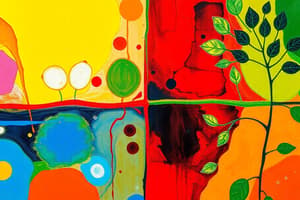Podcast
Questions and Answers
Which of the following best describes the role of the electron transport chain (ETC) in photosynthesis?
Which of the following best describes the role of the electron transport chain (ETC) in photosynthesis?
- Directly produces glucose from carbon dioxide.
- Captures sunlight to excite electrons in chlorophyll.
- Splits water molecules to release oxygen.
- Transfers electrons between Photosystem II and Photosystem I, generating ATP and NADPH. (correct)
How are the light-dependent and light-independent reactions of photosynthesis interconnected?
How are the light-dependent and light-independent reactions of photosynthesis interconnected?
- They occur simultaneously in the same location.
- The light-dependent reactions produce glucose, which is then used in the light-independent reactions.
- The light-independent reactions produce oxygen, which is essential for the light-dependent reactions.
- The light-dependent reactions produce ATP and NADPH, which are used to fuel the light-independent reactions. (correct)
During photosynthesis, water molecules are split. What is the most important purpose of this process?
During photosynthesis, water molecules are split. What is the most important purpose of this process?
- To regulate the temperature of the plant.
- To produce carbon dioxide.
- To provide electrons for the electron transport chain. (correct)
- To produce glucose.
In cellular respiration, what is the main purpose of oxygen?
In cellular respiration, what is the main purpose of oxygen?
How does ATP synthase contribute to both photosynthesis and cellular respiration?
How does ATP synthase contribute to both photosynthesis and cellular respiration?
Which statement accurately compares the roles of ATP and NADPH in cells?
Which statement accurately compares the roles of ATP and NADPH in cells?
What is the primary role of Rubisco in the Calvin cycle?
What is the primary role of Rubisco in the Calvin cycle?
How do enzymes facilitate biochemical reactions within cells?
How do enzymes facilitate biochemical reactions within cells?
Why is fermentation an essential process for cells under anaerobic conditions?
Why is fermentation an essential process for cells under anaerobic conditions?
Which of the following best describes the induced fit model of enzyme function?
Which of the following best describes the induced fit model of enzyme function?
Flashcards
Photosynthesis
Photosynthesis
Process using sunlight, water, and carbon dioxide to produce glucose and oxygen.
Light Independent Reactions (Calvin Cycle)
Light Independent Reactions (Calvin Cycle)
The cycle occurs in the stroma of chloroplasts, uses ATP and NADPH, and produces glucose.
Light Dependent Reactions
Light Dependent Reactions
Occurs in the thylakoid membranes, requires sunlight, splits water, and produces ATP and NADPH.
Photosystems I and II (PSI and PSII)
Photosystems I and II (PSI and PSII)
Signup and view all the flashcards
Electron Transport Chain (ETC)
Electron Transport Chain (ETC)
Signup and view all the flashcards
Chloroplasts
Chloroplasts
Signup and view all the flashcards
Cellular Respiration
Cellular Respiration
Signup and view all the flashcards
Glycolysis
Glycolysis
Signup and view all the flashcards
Krebs Cycle
Krebs Cycle
Signup and view all the flashcards
Oxidative Phosphorylation
Oxidative Phosphorylation
Signup and view all the flashcards
Study Notes
- Photosynthesis needs sunlight, water, and carbon dioxide
- Photosynthesis produces glucose and oxygen
- Photosynthesis occurs in two main stages
Light Independent Reactions (Calvin Cycle)
- Occurs in the stroma of chloroplasts
- Does not require light directly, but uses ATP and NADPH from the light reactions
- Produces glucose (C6H12O6), which plants use for energy and growth
- Rubisco is involved
Light Dependent Reactions
- Occurs in the thylakoid membranes of the chloroplasts
- Requires sunlight to excite electrons in chlorophyll
- Splits water molecules (H2O), producing oxygen (O2) as a byproduct
- Converts light energy into ATP (adenosine triphosphate) and NADPH, which store energy for the next stage
- Photosystem I (PSI) and Photosystem II (PSII) are two protein-pigment complexes in the thylakoid membrane
- PSI and PSII drive the light-dependent reactions of photosynthesis, converting light energy into chemical energy
Electron Transport Chain (ETC)
-
Series of protein complexes in the thylakoid membrane that transfers electrons from Photosystem II (PSII) to Photosystem I (PSI)
-
Generates ATP and NADPH, which power the Calvin cycle
-
Photosystem II splits water (H2O) and starts the electron transport chain
-
Photosystem I produces NADPH
Chloroplasts
- Organelles found in plant cells and some algae
- Photosynthesis occurs here, converting sunlight into chemical energy (glucose) while releasing oxygen
- Contains thylakoids, which are complex proteins needed for photosynthesis
- Chlorophyll inside the thylakoid membrane absorbs light energy
Cellular Respiration
- Cells break down glucose into usable energy
- Mainly takes place in mitochondria
- Breaks down glucose
- Produces energy in the form of ATP
- Needs glucose and oxygen
- Has 3 stages
Glycolysis
- Occurs in the cytoplasm
- Anaerobic process
- Breaks down glucose (C6H12O6) into two molecules of pyruvate (C3H4O3)
- Produces 2 ATP and 2 NADH (energy carriers)
Krebs Cycle
- Occurs in the mitochondrial matrix
- Pyruvate is converted into Acetyl-CoA, which enters the cycle
- Releases CO2 as a waste product
- Produces 2 ATP, NADH, and FADH2 (electron carriers)
Oxidative Phosphorylation
- NADH & FADH2 donate electrons to the ETC
- Electrons move through protein complexes, pumping protons (H+) into the intermembrane space, creating a proton gradient
- Oxygen (O2) acts as the final electron acceptor, forming water (H2O)
- ATP Synthase uses the proton gradient to generate ~34 ATP
ATP
- Contains adenine (a nitrogenous base)
- Contains ribose (a five-carbon sugar)
- Contains three phosphate groups (Triphosphate)
- Energy currency for life
ADP
-
Contains adenine (a nitrogenous base)
-
Contains ribose (a five-carbon sugar)
-
Contains two phosphate groups (Diphosphate)
-
Metabolism includes all chemical reactions that occur in cells
-
Anabolism and catabolism
NADPH
- Energy carrier
- Can store and transfer high-energy electrons
- Essential molecule in photosynthesis and other cellular processes that is an electron carrier
- Provides high-energy electrons for biosynthesis and energy production
ATP Synthase
-
Enzyme that produces ATP (Adenosine Triphosphate)
-
Plays a crucial role in both photosynthesis and cellular respiration by converting ADP and inorganic phosphate (Pi) into ATP using a proton gradient
-
Anaerobic: without oxygen
-
Aerobic: with oxygen
Enzymes
-
Molecules that speed up chemical reactions
-
Substrates are molecules that react to form new products
-
Active site is a region on an enzyme that binds to a protein or other substance during a reaction
-
Induced fit describes how enzymes and proteins change shape to bind to substrates
-
Fermentation uses microorganisms to break down organic compounds into simpler molecules
Studying That Suits You
Use AI to generate personalized quizzes and flashcards to suit your learning preferences.




